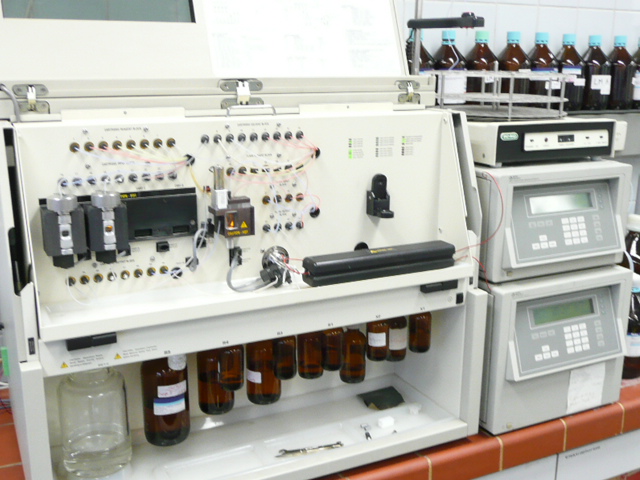N-Terminal and Internal Protein Sequencing by Edman Degradation
Equipment:
ABI Procise Model 492 Edman Micro Sequencer which is online connected to an ABI Model 140C PTH Amino Acid Analyzer.
Method:
The chemical process employed by the protein sequencer to determine the amino acid sequence is derived from the degradation method developed by Pehr Edman. In the first step the free N-terminal amino acid is converted by phenylisothiocyanate to its phenylthiocarbamoyl derivative under mild alkaline conditions. Then this derivative of the N-terminal amino acid is cleaved as a thiazolinone derivative under acidic conditions. After extraction the thiazolinone amino acid it is converted to the more stable phenylthiohydantoin amino acid derivative that can be identified by using chromatography. A standard mixture of 19 PTH-amino acids is also injected onto the column for separation (usually as the first cycle of the sequencing run). This chromatogram provides standard retention times of the amino acids for comparison with each Edman degradation cycle chromatogram.
Provided Services:
-
N-terminal sequencing of unblocked peptides and proteins:
We are offering microsequencing of unblocked protein/peptide samples, either PVDF membrane bound, solid or dissolved. N-terminal sequencing is performed in gas phase or pulsed-liquid mode. If proteins are N-terminally blocked we also offer internal protein sequencing. -
Internal protein sequencing:
Internal sequencing of proteins is performed after enzymatic or chemical protein cleavage.
The proteolytic peptides are separated by RP-HPLC and peptide fractions obtained are then analyzed by N-terminal sequencing.
Sequencing is generally performed on PVDF membranes or glass fiber filters.
Sample Preparation:
| Sample Amount: |
10-100 pmols is preferred (depending on the length of the sequence to be determined), although lower amounts are acceptable. |
| Sample Form: | 1. In 5-100 microliters of volatile solvents such as water, acetonitrile, acetic acid, or formic acid. 2. Pure lyophilized sample is also acceptable. |
|
3. On a PVDF membrane (not nitrocellulose). Blot buffer must not contain components with free amino groups, e.g. glycine, Tris. A suitable protocol using borate can be downloaded here. |
|
| Purity: |
Liquid samples should contain only one protein or peptide. SDS, amino acids, amines, and other contaminants interfering with Edman degradation must be removed from the sample. Samples submitted on PVDF should have well separated bands to minimize contamination. |
| Cysteine Modification: |
Since unmodified Cys residues cannot be detected, Cys must be chemically modified. If you wish to identify Cys, please mark this on the sample submission form. |
| N-terminal blockage: |
If the amino terminus is blocked, the protein or peptide cannot be sequenced using Edman degradation. Go to: Internal protein sequencing |
Depending on sample amount, amino acid sequence and customer’s needs at least 5 to about 40 amino acid residues can be sequenced per sample.
Expect turnaround times of ten business days.
Fees for N-terminal sequencing:
See our price list in the Pricing folder.
Note: If the sample is N-terminally-blocked or the sample amount too low then the setup fee + 5 cycles only will be charged.
Internal protein sequencing
For further details and price, please contact us at “e-mail”
Sample Submission Form: Download "here".




